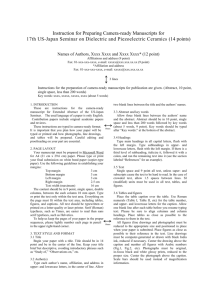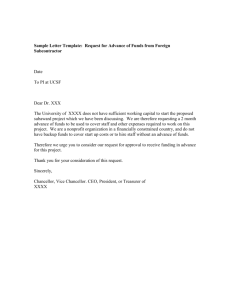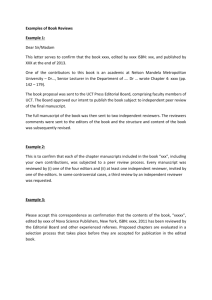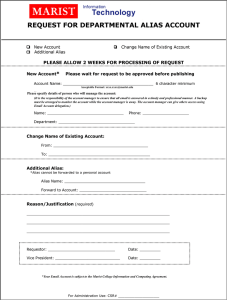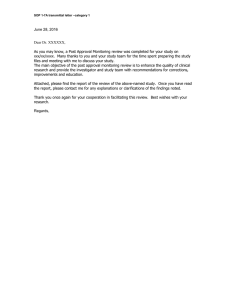Click here to download file.
advertisement
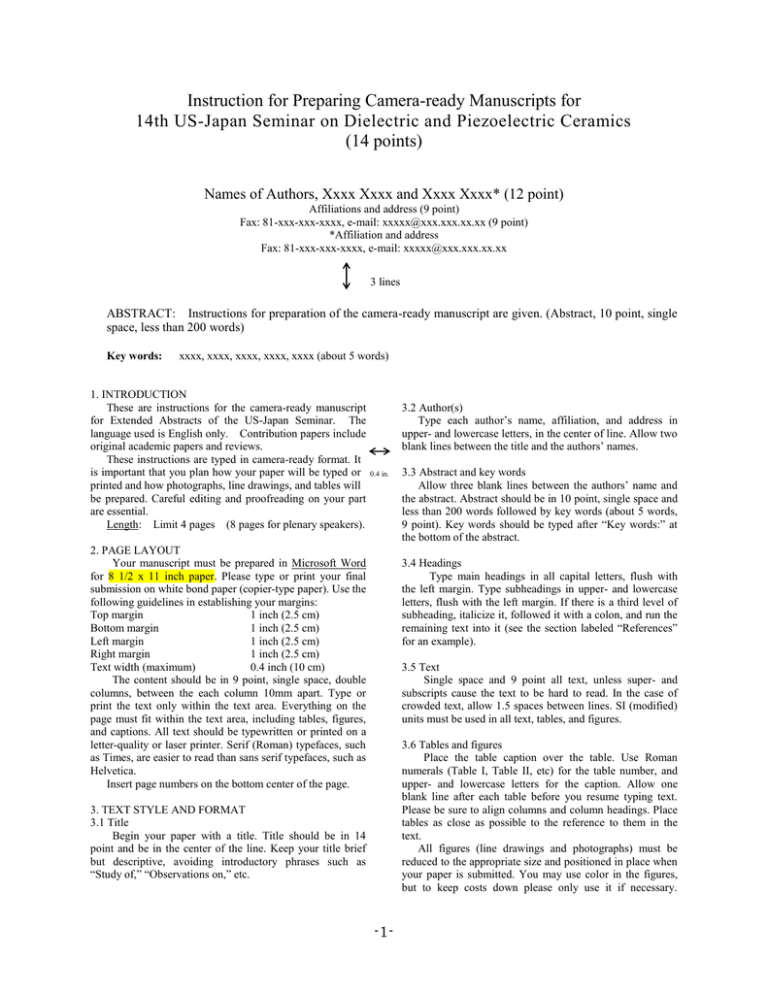
Instruction for Preparing Camera-ready Manuscripts for 14th US-Japan Seminar on Dielectric and Piezoelectric Ceramics (14 points) Names of Authors, Xxxx Xxxx and Xxxx Xxxx* (12 point) Affiliations and address (9 point) Fax: 81-xxx-xxx-xxxx, e-mail: xxxxx@xxx.xxx.xx.xx (9 point) *Affiliation and address Fax: 81-xxx-xxx-xxxx, e-mail: xxxxx@xxx.xxx.xx.xx 3 lines ABSTRACT: Instructions for preparation of the camera-ready manuscript are given. (Abstract, 10 point, single space, less than 200 words) Key words: xxxx, xxxx, xxxx, xxxx, xxxx (about 5 words) 1. INTRODUCTION These are instructions for the camera-ready manuscript for Extended Abstracts of the US-Japan Seminar. The language used is English only. Contribution papers include original academic papers and reviews. These instructions are typed in camera-ready format. It is important that you plan how your paper will be typed or printed and how photographs, line drawings, and tables will be prepared. Careful editing and proofreading on your part are essential. Length: Limit 4 pages (8 pages for plenary speakers). 3.2 Author(s) Type each author’s name, affiliation, and address in upper- and lowercase letters, in the center of line. Allow two blank lines between the title and the authors’ names. 0.4 in. 2. PAGE LAYOUT Your manuscript must be prepared in Microsoft Word for 8 1/2 x 11 inch paper. Please type or print your final submission on white bond paper (copier-type paper). Use the following guidelines in establishing your margins: Top margin 1 inch (2.5 cm) Bottom margin 1 inch (2.5 cm) Left margin 1 inch (2.5 cm) Right margin 1 inch (2.5 cm) Text width (maximum) 0.4 inch (10 cm) The content should be in 9 point, single space, double columns, between the each column 10mm apart. Type or print the text only within the text area. Everything on the page must fit within the text area, including tables, figures, and captions. All text should be typewritten or printed on a letter-quality or laser printer. Serif (Roman) typefaces, such as Times, are easier to read than sans serif typefaces, such as Helvetica. Insert page numbers on the bottom center of the page. 3.3 Abstract and key words Allow three blank lines between the authors’ name and the abstract. Abstract should be in 10 point, single space and less than 200 words followed by key words (about 5 words, 9 point). Key words should be typed after “Key words:” at the bottom of the abstract. 3.4 Headings Type main headings in all capital letters, flush with the left margin. Type subheadings in upper- and lowercase letters, flush with the left margin. If there is a third level of subheading, italicize it, followed it with a colon, and run the remaining text into it (see the section labeled “References” for an example). 3.5 Text Single space and 9 point all text, unless super- and subscripts cause the text to be hard to read. In the case of crowded text, allow 1.5 spaces between lines. SI (modified) units must be used in all text, tables, and figures. 3.6 Tables and figures Place the table caption over the table. Use Roman numerals (Table I, Table II, etc) for the table number, and upper- and lowercase letters for the caption. Allow one blank line after each table before you resume typing text. Please be sure to align columns and column headings. Place tables as close as possible to the reference to them in the text. All figures (line drawings and photographs) must be reduced to the appropriate size and positioned in place when your paper is submitted. You may use color in the figures, but to keep costs down please only use it if necessary. 3. TEXT STYLE AND FORMAT 3.1 Title Begin your paper with a title. Title should be in 14 point and be in the center of the line. Keep your title brief but descriptive, avoiding introductory phrases such as “Study of,” “Observations on,” etc. -1- Place figures as close as possible to their reference in the text. Line drawings must be computer-generated or drawn with black India ink, reduced if necessary. Center the drawing above the caption and number all figures with Arabic numbers (Fig.1, Fig.2, etc). Photographs must be original, in-focus black and white glossy prints, reduced to the proper size. Center the photograph above the caption. Scale bars should be used instead of magnification information. 4. SUBMITTING YOUR MANUSCRIPT Please submit an electronic copy of the manuscript in two different formats: Microsoft Word pdf Please upload BOTH files to: https://secure.oregonstate.edu/ocs/register.php?event=342 3.7 Equations and Greek Characters Equations should be centered on the page, separated from the text by one blank line above and below. If an equation is too long to fit on one line, indent subsequent lines from the left margin. Number equations consecutively in parentheses at the right-hand margin, in line with the last line of the equation. If for any reason you have difficulty, you may also email the files directly to: Prof. David Cann Oregon State University cann@engr.orst.edu You will receive confirmation of receipt of your electronic submission. 3.8 Footnotes If footnotes are necessary, identify them with an asterisk and type them at the bottom of the appropriate page. If more than one footnote will appear on a page, identify them with multiple asterisks (**,***, etc.) or other distinctive symbols. 5. SUBMISSION DEAD LINE: July 1, 2009 3.9 References Number references consecutively in the text, either with superscript numbers or with numbers in brackets, and list the references at the end of the paper in the order in which they are cited in the text. Include the following information: Articles: Author’s initials and surname (provide for all authors of an article), name of periodical, volume number, inclusive page numbers, and year of publication. In the case of articles from non-English publications, an English translation of the title should also be given. Example: [1] J. S. Kaper and J. S. Prener, Acta Crystallogr., 7, 246-48 (1954). Books: Author’s initials and surname (provide for all authors of a title), book title, edition, editor, publisher, publisher’s location, and year published, specific pages referred to. Example: [2] F. Izumi, “The Rietveld Method”, Ed. by R. A. Young, Oxford University press, Oxford (1993) pp. 121-24. Patents: Author, title, patent number, country of issue, and issue date. A list of references, with complete bibliographic information, must appear at the end of your paper. It is not necessary to -2-
